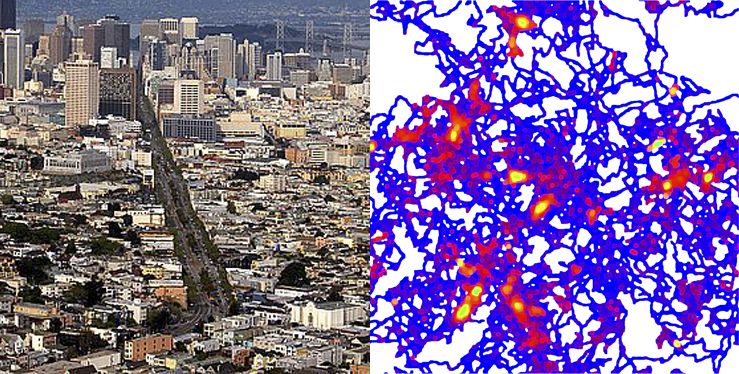How does P. aeruginosa organize into microcolonies?
 Biofilms have been previously compared to bacterial cities. It turns out there
is an interesting connection to ‘rich-get-richer’ economics also. Much existing
work has been done on factors impacting surface adhesion of cells that make up a
biofilm, and it is known that P. aeruginosa secretes the Psl
exopolysaccharide, which promotes surface attachment by acting as a ‘molecular
glue’. The first step in the social organization of biofilms, however, is the
formation of microcolonies, groups of <50 cells that seem to spontaneously
aggregate and thereby nucleate the growth of the biofilm. Despite decades of
work, it is not well understood precisely how individual surface-attached
bacteria self-organize into microcolonies. In this manuscript, we identify a new
role for Psl in early biofilm development using a recently developed
cell-tracking algorithms to extract the motility history of every cell. By
combining these techniques with fluorescent Psl staining and state-of-the-art
computer simulations, we show that P. aeruginosa cells deposit trails of Psl
as they move on a surface. This communally secreted, intersecting Psl web
drastically influences the surface exploration strategy of subsequent cells that
encounter these trails, dictating the probabilities of where cells go and how
long they stay. In fact, our data quantitatively show that the web of secreted
Psl ultimately leads to a steep distribution of surface visit frequencies (i.e.
how often a given surface patch is visited by cells) that can be approximated by
a power law, driven by large heterogeneities in the distribution of Psl. This
constitutes one type of ‘Zipf’s law’ behavior, which is a form of
‘rich-get-richer’ phenomena in nature. Our results indicate that the bacterial
community self-organizes in a manner analogous to a capitalist economic system,
a ‘rich-get-richer’ mechanism of Psl accumulation that results in a small number
of ‘elite’ cells extremely enriched in communally produced Psl. Using engineered
strains with inducible Psl production at different rates, we show that local Psl
levels determine post-division cell fates and that high local Psl levels
ultimately allow ‘elite’ cells to serve as the founding population for initial
microcolony development. The surface movements of bacteria have always seemed
random and complex, but we now know what they are trying to do and find
astonishingly quantitative agreement between our simple model and the observed
behavior
Biofilms have been previously compared to bacterial cities. It turns out there
is an interesting connection to ‘rich-get-richer’ economics also. Much existing
work has been done on factors impacting surface adhesion of cells that make up a
biofilm, and it is known that P. aeruginosa secretes the Psl
exopolysaccharide, which promotes surface attachment by acting as a ‘molecular
glue’. The first step in the social organization of biofilms, however, is the
formation of microcolonies, groups of <50 cells that seem to spontaneously
aggregate and thereby nucleate the growth of the biofilm. Despite decades of
work, it is not well understood precisely how individual surface-attached
bacteria self-organize into microcolonies. In this manuscript, we identify a new
role for Psl in early biofilm development using a recently developed
cell-tracking algorithms to extract the motility history of every cell. By
combining these techniques with fluorescent Psl staining and state-of-the-art
computer simulations, we show that P. aeruginosa cells deposit trails of Psl
as they move on a surface. This communally secreted, intersecting Psl web
drastically influences the surface exploration strategy of subsequent cells that
encounter these trails, dictating the probabilities of where cells go and how
long they stay. In fact, our data quantitatively show that the web of secreted
Psl ultimately leads to a steep distribution of surface visit frequencies (i.e.
how often a given surface patch is visited by cells) that can be approximated by
a power law, driven by large heterogeneities in the distribution of Psl. This
constitutes one type of ‘Zipf’s law’ behavior, which is a form of
‘rich-get-richer’ phenomena in nature. Our results indicate that the bacterial
community self-organizes in a manner analogous to a capitalist economic system,
a ‘rich-get-richer’ mechanism of Psl accumulation that results in a small number
of ‘elite’ cells extremely enriched in communally produced Psl. Using engineered
strains with inducible Psl production at different rates, we show that local Psl
levels determine post-division cell fates and that high local Psl levels
ultimately allow ‘elite’ cells to serve as the founding population for initial
microcolony development. The surface movements of bacteria have always seemed
random and complex, but we now know what they are trying to do and find
astonishingly quantitative agreement between our simple model and the observed
behavior